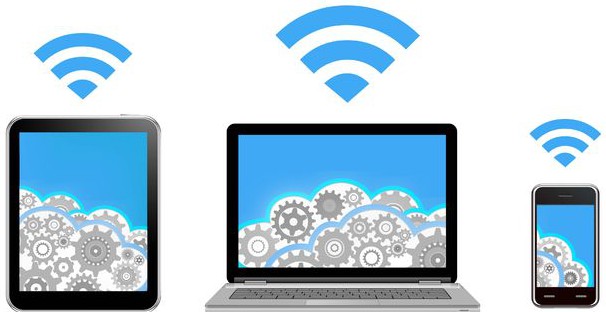Easy WiFi Home Network
Ahhh yes, life’s pretty sweet with that high speed DSL or cable line. But there is a glitch. A normal ISP dial up account can be used from any computer in the world; but DSL or cable connects to only one computer.
The obvious solution would be to install a network to carry the signal to every computer in the house. I’d steered clear of a having network in my home office for many years. I once spent several days trying to hook up 2 computers using Windows 95, and finally gave up after only intermittently being able to make the computers communicate. I swore that my days on the floor with my computers open were over and I ran my own “network” by transferring Zip disks from one computer to another
Lucky for us non-techie types, networks are considerably more home-network-friendly than in the old days. Also, more pleasant modes of networking (other than having miles of Ethernet cables snaking around the walls of your house) came to the fore of technology.
By networking your home (or office) you’ll save time by having the flexibility to work from different rooms or locations. You can also list items out by the pool (or in your backyard) in summer!
Why a network?
A network is a way to connect computers so that they can communicate with each other – as if they were one giant computer with different terminals. The best part is that a network enables all those computers to share a single high-speed Internet connection-sharing, as well as the sharing of printers and other peripherals. By setting up a network, several computers, tablets, phones or TVs can access the internet . From each networked computer, it’s possible to access other networked computers and peripherals. You can connect as many devices as you like, and run your business from anywhere in your home – you can even hook up your laptop from the bedroom if you don’t feel like getting out of bed.
In networked computers, you can set directories in each computer to be shared. That way, other computers on the network can access those directories. You can also password-protect specific files and directories to prevent others (your children or your employees) from accessing them.
Wireless networking (also known WiFi or, to the more technically inclined, IEEE 802.11 is the go-to technology for all kinds of networks. It’s an impressive system when it works, with no cables or connectors to bog you down.
If you’re worried about your next-door neighbor hacking into your computer through your wireless connection, stop worrying. Wireless networks are protected by their own brand of security, called WPA (Wi-Fi Protected Access). WEP encrypts your wireless transmissions and prevent others from getting into your network. Another flavor of security is WPA, which is even more secure. Although super-hackers have cracked this system, it’s the best currently available for the home office user.
WPA utilizes a “pre-shared key” (PSK) mode, where every user on the network is given the same passphrase. In the PSK mode, security depends on the strength and secrecy of the passphrase. So, to link your laptop or desktop to a wireless network with WPA encryption, you need the pre-determined passphrase. Just enter it during setup – on every computer that uses the network – and you should be good to go.
Installing your wireless network isn’t a gut-wrenching experience either (although it can be if the signal doesn’t reach where you want it). You hook up your computer (a laptop works best) to the wireless access point (the gizmo with the antenna that broadcasts your signal throughout your home or office) to perform some setup tasks such as choosing your channel and setting up the WPA code. (The wireless access point often comes with a preset WPA code).
After you complete the setup and turn on your wireless access point, you have a WiFi hotspot in your home or office. Typically, a hotspot provides coverage for about 100 feet in all directions, although walls and floors cut down on the range.
Here are the very simple steps to configure your network:
- Run a cable from your DSL or cable line to your modem.
- Connect an Ethernet cable from your modem to your router
- Connect one Ethernet cable to your wireless access point.
- Type in the passphrase to all computers on the network.
Once you’ve accomplished all this, you can now share printers, files, video, music and internet connections throughout your home; without using the “sneakernet” of the past. I don’t know how I ever worked without this before – it’s really changed my life.
For more information on how to set up hybrid networks, such as with powerline (through your electrical wiring), there’s and entire chapter in my latest edition of eBay Business All-in-One For Dummies.

